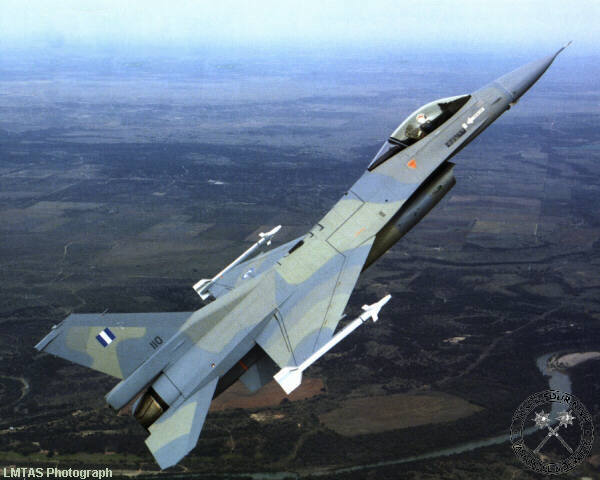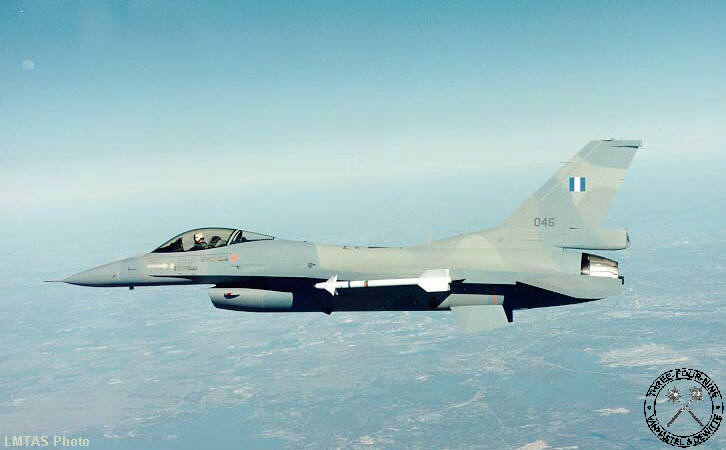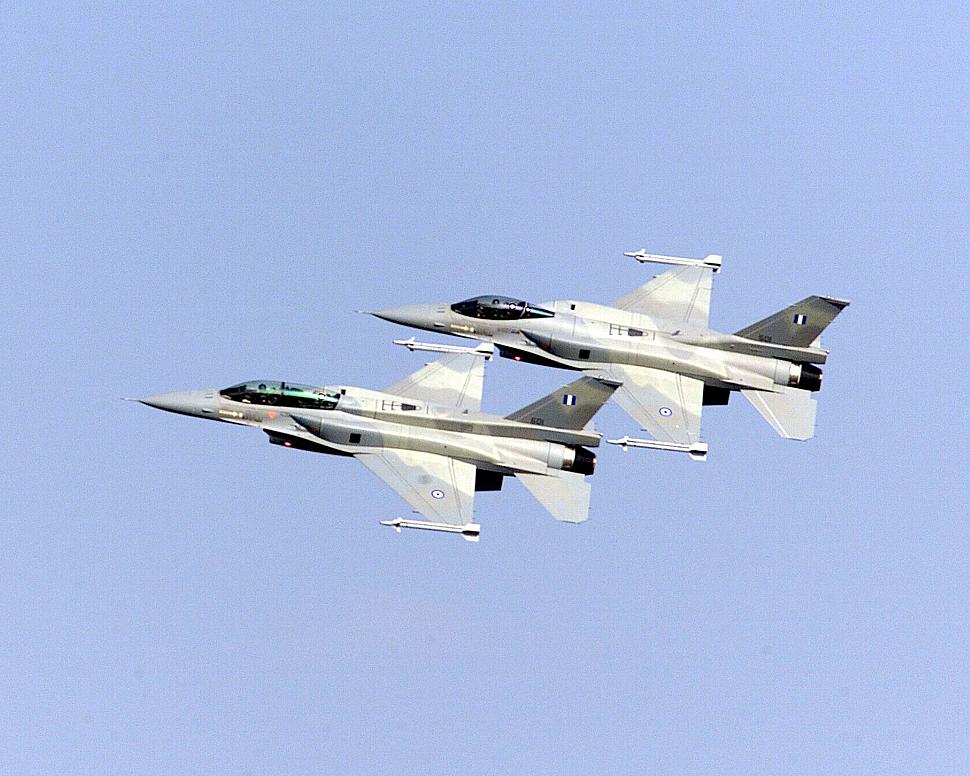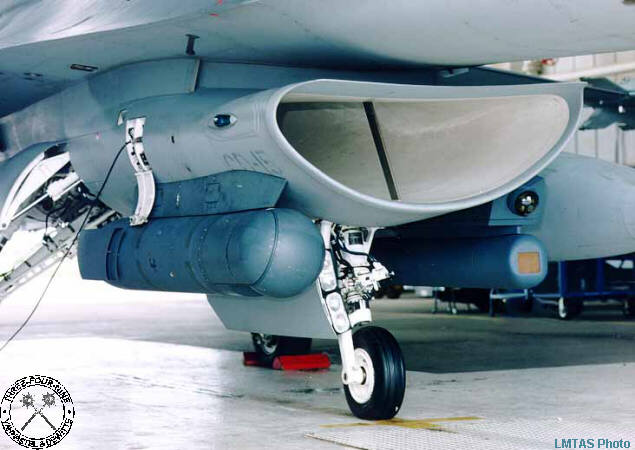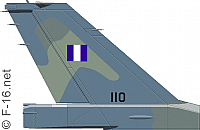 |
Greece
Elliniki Aeroporia
|
Introduction
The Hellenic Air Force (or Greek Air Force) has ordered a total of 170 F-16 aircraft, including F16CD block 30, 50, and 52 aircraft. These aircraft are equiped with state-of-the-art weapon systems: JDAM, JSOM, and WCMD ground attack munitions; IRIS-T and AIM-120C AMRAAM air-to-air missiles; JHMCS and NVG for the pilots; LANTIRN navigation and targeting system; and ASPIS electronic warfare suite.The latest order of block 52 aircraft are equiped with conformal fuel tanks, in order to give them the range to cover Cyprus.
History
Greece has been a member of NATO since 1952, and has played an important role in defending NATO's southern flank. However, it has also been involved in a long-term rivalry with its neighbor (and NATO-partner) Turkey over territorial rights in the Agean see and in particular over the status of Cyprus. Numerous incidents occurred in the past years, more often than not involving both countries air forces. Consequently, arms supplied to Greece and Turkey have often been directed more against each other rather than against Soviet expansion.
It has often been felt necessary to supply the same weapons at the same time to both Greece and Turkey in order to prevent any force imbalances from developing between these two rivals. In November of 1984, shortly after Turkey announced its plans to purchase F-16s, Greece announced that it was going to acquire 34 F-16C and six F-16D fighters to replace the F-5A Freedom Fighter. The formal agreement was signed in January 1987, after years of protracted haggling over price and the repeated expression of worries on the part of the US about the danger of technology transfer to the Warsaw Pact.
Inventory
Peace Xenia I
The first batch of F-16C/D's for Greece, acquired under the Peace Xenia I Foreign Military Sales Program were Block 30 aircraft, powered by the General Electric F110-GE-100 turbofan. The first F-16D for the Elliniki Aeroporia (Hellenic Air Force) was handed over at Fort Worth on November 18th, 1988, with the first F-16C being handed over later that same month. The initial batch was delivered between November 1988 and October 1989. Hellenic F-16s are assigned USAF serial numbers for administrative purposes and carry the last three digits of it on their tails.
Peace Xenia II
In April of 1993, General Dynamics received an additional order from Greece for 40 more F-16CJ/DJ block 50 fighters (32 Charlie and 8 Delta models). The aircraft are powered by the General Electric F110-GE-129 engine, and are provided to Greece under Peace Xenia II.
The first two F-16 Block 50 aircraft for Greece (a C and a D model) rolled out of the factory at Lockheed Martin Tactical Aircraft Systems on the same day, January 28th, 1997 - over a month ahead of schedule. The single-seat F-16C, which was two months ahead of the delivery schedule, was used to validate Technical Orders associated with systems peculiar to the Greek Block 50 configuration. After this validation work, flight instrumentation was installed. Painting, ground testing and functional check flights were followed by a traditional F-16 delivery ceremony, held in Fort Worth on May 22nd, 1997. The aircraft was accepted by Lt. Gen. Dimitrios Litzerakos. Subsequently, the aircraft went to Edwards for further flight testing after which it will become part of Greece's operational fleet. The F-16DJ followed the normal production path and was signed off about a month ahead of schedule. Before heading to its new home in Greece, the two-seat model was used for training Greek maintenance crews in Fort Worth. Initial aircraft are also used for pilot training at Luke AFB. The production rate is two per month for 20 months.
On July 24th, 1997, the first 4 F-16s made the ferry flight (CORONET EAST 189) from Shaw AFB to Ramstein AB, Germany. The flight (callsign Retro 21-24) consisted of the following aircraft: F-16C #93-1047 and #93-1048, F-16D #93-1078 and #93-1079; Greek serials being #047, #048, #078, #079 respectively. Deliveries were scheduled to go through Spangdahlem AB (since it houses USAFE F-16s which would make maintenance easier), but due to ongoing runway repairs at Spang, the aircraft had to divert to nearby Ramstein AB.
Block 30 Order (Cancelled)
In 1998, NATO asked Greece to assign the nuclear strike role to F-16 units, a request that was turned down by Athens since the HAF needed its scarce F-16 resources for air defense and conventional ground attack missions. The nuclear strike role was at the time performed by the A-7 corsairs from 335 and 336 Mira (forming the 116th Combat Wing) at Araxos, with (US-owned) B61-5 lightweight (350kg), low-drag/parachute -retarded, radar-fuzed, variable-yield (10-500kT) tactical thermonuclear weapons.
Greece considered the option to 'cascade' a squadron of surplus F-16A/B's from a NATO ally (USA, Belgium or The Netherlands); this squadron was to be based at Araxos with the two Corsair units and to be dedicated to the NATO strike role. Through the Mid-Life Update program, the aircraft could be brought to a standard more level with the HAF's existing F-16 fleet.
In August 1998, Greece signed an agreement with the US government to buy 20 ex-USAF Block 30 F-16s. The aircraft, costing USD $12 million a piece, would be upgraded to Block 50 standard by Hellenic Aerospace Industries. It was very likely that these aircraft would perform the nuclear strike role at Araxos.
After a lot of discussion in the Greek military and political establishment, they decided that such a purchase was not to the benefit of their defenses and was ill-suited to do the job it required. The fact that the latest batch of Greek F-16s were already of the Block 50 type, made it very hard to convince the Greek military of the use of buying second-hand and less capable equipment. The deal was cancelled not long after signing the contract and other solutions were persued.
Peace Xenia III
In order to counter the expansion of the Turkish Air Force, who fields about 240 F-16C/D aircraft, the Hellenic AF looked for up to 60 additional fighter aircraft. Candidates for the new HAF fighter were the Boeing-McDonnell Douglas F-15H, Sukhoi Su-27/30, Lockheed Martin F-16C/D Block 50, Dassault Mirage 2000-5, and Eurofighter Typhoon. Greece planned to spend $17 billion on its military over 10 years at that time, with the biggest share going to the air force.
In February 1999, two years of effort to revitalize the Greek air force came to a halt after the government admitted it had no money to buy the 60 new fighter jets the military wanted. Their budget stood around $1.5 billion while the cost for all 60 planes was double, at best.
Greece's top brass had opted for the F-15 which had the best test reviews but its high price, about $75 million each, rendered the purchase prohibitive. The F-16 cost about $45 million and the Mirage about $58 million. The officials said a combination of all three types of planes being purchased was also being examined.
At the end of the competition, Mr. Tsohatzopoulos, the Greek minister of defense, said that Greece would start negotiations to become part of the Eurofighter Typhoon production process and saw itself buying between 60 and 80 planes after 2005. Because of the Olympic Games, due in Athens in 2004, the government decided once again to at least postpone the Typhoon purchase. Instead, in June 2000, they finally ordered 50 brand new F-16 Block 52 fighters with an option of 10 more (exercised in September 2001), consisting out of 40 single-seat aircraft and 20 double-seat aircraft. These aircraft are of the latest batch of Block 52 aircraft equipped with conformal fuel tanks.
On June 8th, 2004 the last 2 of these batch of F-16s was delivered to the Hellenic Air Force. All F-16s were produced in just 31 months from receipt of the LoA. Normally it takes up to 36 to 42 months to accomplish this.
Peace Xenia IV
Since the cancellation of the Typhoon deal, rumours existed whether the Greek government would buy more F-16s instead. In July of 2005 a first glimpse of a new fighter deal was noted. Ultimately, on December 13th, 2005 the Greek government signed a LOA for the delivery of 30 new block 52 F-16s with an option on 10 more. The first batch consists of 20 C-models and 10 D-models. Total contract value is estimated at $3.1 billion if all options are exercised.
The total package also includes the delivery of 40 F100-PW-229 engines and APG-68(V)9 radars, 42 JHMCS, 40 AN/AVS-9 Generation III NVG's, 190 LAU-129/A launchers, 48 Link-16 MIDS-LVT, 3 Link-16 ground stations, 10 LANTIRN pods, 11 recce pods, 2 recce ground stations, 40 APX-113 Advanced IFF systems, 43 AN/ALQ-187 ASPIS, 6 spare F100-PW-229 engines, 3 APG-68(V)9 spare radar sets, 4 AGM-154C JSOW, 6 JDAM (3 BLU-10 and 3 MK-84 bomb bodies) and 4 WCMD's. First deliveries are due in 2009.
On March 15th, 2006 the Greek government announced that it turned down the option to buy 10 additional F-16 aircraft from Lockheed Martin.
| Program | Model | Block | Qty. | Serials | Delivered |
|---|---|---|---|---|---|
| Peace Xenia I | F-16C | Block 30 | 34 | 110/143 | 1989-1990 |
| F-16D | Block 30 | 6 | 144/149 | 1989 | |
| Peace Xenia II | F-16C | Block 50 | 32 | 045/076 | 1997-1998 |
| F-16D | Block 50 | 8 | 077/084 | 1997-1998 | |
| Peace Xenia III | F-16C | Block 52 | 34 | 500/533 | 2002-2004 |
| F-16D | Block 52 | 16 | 600/615 | 2002-2004 | |
| Option | F-16C | Block 52 | 6 | 534/539 | 2004 |
| F-16D | Block 52 | 4 | 616/619 | 2004 | |
| Peace Xenia IV | F-16C | Block 52 | 20 | 001-020 | 2009-2010 |
| F-16D | Block 52 | 10 | 021/030 | 2009-2010 |
Modifications & Armament
Block 30 Falcon-Up
The Block 30 fleet went through the mid-life 'Falcon-Up' upgrade program at Hellenic Aerospace Industry. The first aircraft entered Hellenic Aerospace Industry in September 1996. The aircraft was handed back to the HAF on July 15th, 1997. Work includes major disassembly of the aircraft, replacement of four major structural components of the fuselage. The improvements prolong the aircraft lifetime from 4000hrs to 8000hrs.
Targeting & Navigation Pods
Greece also improved the night attack capabilities of its Block 30 aircraft by equipping them with directly purchased, commercially available systems. The fact that Greece did not buy the LANTIRN system at first generated some friction between the USA and Greece. Greece later ordered some 24 LANTIRN navigation pods and 16 targeting pods for its Block 50 fleet.
Armament
150 AIM-120B as well as 82 AGM-88B HARM missiles were ordered to equip both Block 30 and Block 50 aircraft. On October 9th, 1997, the Government of Greece announced the procurement of 90 more AIM-120 Advanced Medium-Range Air-to-Air Missiles (AMRAAM), missile containers, and other related elements of logistics and program support. The estimated cost is $42 million.
On December 21st, 2001, the Greek government signed a contract to buy up to 350 IRIS-T air-to-air missiles, with an option for 100 more. These will be used to re-equip the F-16s with a more potent air-to-air weapon. By August 2003, a further 100 AIM-120C5 AMRAAM missiles will have been delivered to the HAF for the use on the F-16 fleet.
Other
Greek Block 30's are the only F-16s which have a searchlight on the starboard side of the fuselage, just below and in front of the canopy.
The HAF F-16s will shortly receive Litton's ASPIS electronic warfare suite (Advanced Self-Protection Integrated Suite) which will be internally mounted and includes:
- ALQ-187 I-DIAS jamming system
- ALR-66VH (I) RWR
- ALE-47 Chaff & Flare Dispenser
Operational Service
Units
Please refer to the F-16 Units section for an overview of units.Deployments
|
Combat Over the years, Greek F-16s have often been involved in fights with Turkish Aircraft over the much disputed parts of the Aegean Sea. F-16s are scrambled constantly to intercept Turkish intruders and vice-versa. A lot of rumors exist involving aircraft being shot down on both sides of the borders. We are working on a more accurate account of these events. All contributions are welcome of course! |
Special thanks
- Andreas Kominos;
- Tassos Raftopoulos.
116 PM aditional squadron SMET "Achaios" since 2012
Status active
F16 C/D block 52
Role :Training
Recommend to include the above SQN
For further details call 2693055190
Best regards
LtCol Apostolos "Vader" Maniatellis
"Achaios " SQN Commander
Name for the Hellenic Air Force in Greek is Polemiki Aeroporia instead of what is displayed here.
Thanks. Black skies and headwinds.
Lt Col Achilleas "Flare" Katsos
Please use this form to add any list any error or omissions you find in the above text.
Note: your comments will be displayed immediately on this page. If you wish to send a private comment to the webmasters, please use the Contact Us link.

